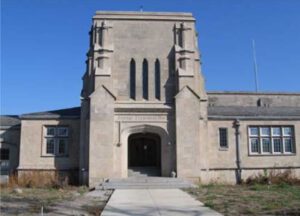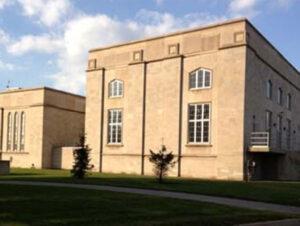The Water Pollution Control Plant is the critical facility that removes harmful bacteria and other pollutants from wastewater before it is released to the river. In fact, water treated and released from the Plant is actually cleaner than the water in the Maumee River. The Fort Wayne Water Pollution Control Plant provides wastewater treatment for the City of Fort Wayne and surrounding areas.
Protecting Public Health and the Environment

Original entrance to the Plant, constructed from 1938–1940
Fort Wayne’s Paul L. Brunner Water Pollution Control Plant – located on Dwenger Avenue east of Anthony Boulevard — provides wastewater (also called sewage) treatment for the City of Fort Wayne and surrounding areas. Following the treatment process, cleaned water (effluent) is released to the Maumee River. The water released from the Plant after treatment process is actually cleaner than the water in the river. Organic matter that is removed from the wastewater (also called sludge) is treated, dried, mixed with composted yard waste and made available as a soil amendment/fertilizer known as biosolids.
Since the Water Pollution Control Plant (WPCP) opened, City Utilities’ commitment to public health and the environment, along with changing environmental regulations, has required a number of expansions and enhancements at the Plant. Because Fort Wayne’s treatment Plant is in the Great Lakes watershed, the quality standards for the treated water released from the Plant are stricter than those that apply to other Plants in Indiana that discharge to water bodies that eventually drain to the Gulf of Mexico. Despite all of the regulatory requirements, in 2017 the Plant operates with only one more employee than it had when it opened in 1941 and sewer rates charged to customers remain in the lower two‐thirds of communities around the region.
History
Fort Wayne’s Water Pollution Control Plant was originally constructed between 1938 and 1940 at a cost of approximately $5.3 million. Funding came from a $2.3 million grant from the federal Public Works Administration and a $3 million bond issued by the City of Fort Wayne. The initial facility provided secondary level treatment utilizing the activated sludge process for an average flow of 24 million gallons per day (MGD). The WPC Plant — like the Three Rivers Water Filtration Plant located at the confluence of Fort Wayne’s three rivers — was constructed in the Collegiate Gothic style. Buildings are covered with Indiana limestone.

The 2005 headworks building was designed to match the style of the original Plant
The quickly growing city soon required that the Plant be expanded to increase capacity. As a result, additions were made in 1960 that provided the capability for primary treatment of 60 MGD and secondary treatment of 32 MGD. Progressively more stringent water quality regulations necessitated the addition of a chlorination facility in 1970. Also during the early 1970s, three ponds were added on the north side of the Maumee River. These can be used to store flows that exceed the Plant’s treatment capacity during wet weather.
In 1975, work began to increase secondary treatment capacity to accommodate an average flow rate of 60 MGD. The increase in capacity allowed the Plant to treat a peak flow rate of 72 MGD. Additionally, two more terminal ponds were constructed on the north side of the Maumee River to increase storm water treatment capability and provide effluent polishing.
Quick Facts
- Current peak treatment capacity: 100 MGD
- Original Plant constructed: 1938–1940
- Dedicated: March 1941
- Chlorination added: 1970
- Capacity addition: 1975
- Nitrogen removal: 1983
- New Headworks: 2005
- New Primary Treatment: 2008
- Wet Weather Pump Station upgrade: 2013–2015
- Design population (1940): 125,000
- Population currently served: 310,000
- Geographic area served 1940: 14.5 sq. miles
- Geographic area served 2015: over 120 sq. miles






 Download the Water Pollution Control Plant Brochure.
Download the Water Pollution Control Plant Brochure.